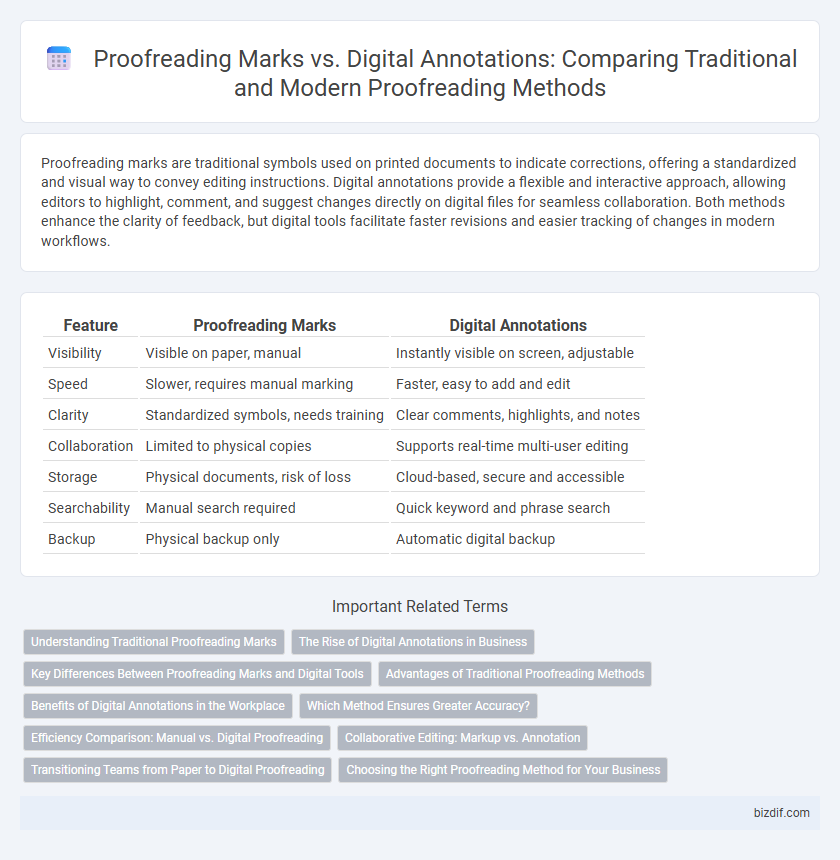Proofreading marks are traditional symbols used on printed documents to indicate corrections, offering a standardized and visual way to convey editing instructions. Digital annotations provide a flexible and interactive approach, allowing editors to highlight, comment, and suggest changes directly on digital files for seamless collaboration. Both methods enhance the clarity of feedback, but digital tools facilitate faster revisions and easier tracking of changes in modern workflows.
Table of Comparison
| Feature | Proofreading Marks | Digital Annotations |
|---|---|---|
| Visibility | Visible on paper, manual | Instantly visible on screen, adjustable |
| Speed | Slower, requires manual marking | Faster, easy to add and edit |
| Clarity | Standardized symbols, needs training | Clear comments, highlights, and notes |
| Collaboration | Limited to physical copies | Supports real-time multi-user editing |
| Storage | Physical documents, risk of loss | Cloud-based, secure and accessible |
| Searchability | Manual search required | Quick keyword and phrase search |
| Backup | Physical backup only | Automatic digital backup |
Understanding Traditional Proofreading Marks
Traditional proofreading marks consist of standardized symbols and abbreviations that editors use to indicate corrections on printed documents, ensuring clarity and consistency in manual editing processes. These marks are essential for communicating precise instructions such as deletions, insertions, or formatting changes directly on physical proofs, enabling efficient collaboration between writers and printers. Understanding these marks enhances accuracy in editing by bridging the gap between traditional print workflows and modern digital annotations.
The Rise of Digital Annotations in Business
Digital annotations have transformed business proofreading by enabling real-time collaboration and precise feedback on documents across multiple platforms. Unlike traditional proofreading marks, digital tools allow seamless integration with cloud-based software, enhancing efficiency and reducing turnaround times. The rise of digital annotations supports remote workflows and ensures accurate version control, essential in fast-paced corporate environments.
Key Differences Between Proofreading Marks and Digital Tools
Proofreading marks are traditional, universally recognized symbols used to indicate errors and corrections directly on physical manuscripts, enabling clear, standardized communication between editors and writers. Digital annotations offer interactive, editable comments and highlights within electronic documents, providing greater flexibility and real-time collaboration across devices and platforms. The key differences lie in the tangible, permanent nature of proofreading marks versus the dynamic, shareable capabilities of digital tools, affecting workflow efficiency and error tracking in editing processes.
Advantages of Traditional Proofreading Methods
Traditional proofreading methods offer precise control through standardized proofreading marks, ensuring clarity and consistency in revisions. These marks facilitate direct, visual communication between editors and writers, reducing misinterpretations common in digital annotations. Physical annotations also enhance focus by minimizing digital distractions, promoting thorough and attentive error detection.
Benefits of Digital Annotations in the Workplace
Digital annotations streamline the proofreading process by enabling real-time collaboration and instant feedback across teams, significantly increasing efficiency. These annotations integrate seamlessly with popular document management systems, enhancing accessibility and version control. Their ability to embed comments, highlight errors, and link resources reduces miscommunication and accelerates document turnaround in the workplace.
Which Method Ensures Greater Accuracy?
Proofreading marks offer standardized, universally recognized symbols that minimize misinterpretation, enhancing accuracy in traditional print editing. Digital annotations provide real-time, precise edits with tools like comments, highlights, and track changes, which streamline collaboration and reduce errors. Combining digitized proofreading marks within digital platforms achieves the highest level of accuracy by merging clarity with efficiency.
Efficiency Comparison: Manual vs. Digital Proofreading
Manual proofreading using traditional marks often requires more time as reviewers must physically mark errors and explanations, which can cause delays during the revision process. Digital annotations streamline efficiency by enabling real-time collaboration, rapid error identification, and instant updates across devices, significantly reducing turnaround times. Studies show digital proofreading increases productivity by up to 40% compared to manual methods, optimizing workflow in publishing and editorial environments.
Collaborative Editing: Markup vs. Annotation
Proofreading marks offer standardized, universally recognized symbols that facilitate precise manual corrections on physical documents, ensuring clear communication among editors and writers. Digital annotations enable real-time collaborative editing with features like inline comments, highlights, and version tracking, enhancing efficiency and flexibility across remote teams. Comparing markup to annotation reveals that while traditional proofreading marks emphasize uniformity and permanence, digital tools prioritize interactivity and seamless integration within cloud-based workflows.
Transitioning Teams from Paper to Digital Proofreading
Transitioning teams from traditional proofreading marks to digital annotations streamlines the editing process, enhancing collaboration and accuracy. Digital tools offer real-time updates, customizable markup options, and easier integration with content management systems, reducing errors and saving time. Embracing digital annotations fosters a more efficient workflow, enabling faster turnaround and improved version control in proofreading projects.
Choosing the Right Proofreading Method for Your Business
Proofreading marks remain the gold standard for print-based documents, providing precise, universally recognized symbols that ensure clarity in editing. Digital annotations offer flexibility and efficiency for collaborative workflows, enabling real-time feedback and seamless integration with various software platforms. Choosing the right proofreading method depends on your business's document format, team collaboration needs, and preference for speed versus traditional accuracy.
Proofreading marks vs Digital annotations Infographic

 bizdif.com
bizdif.com